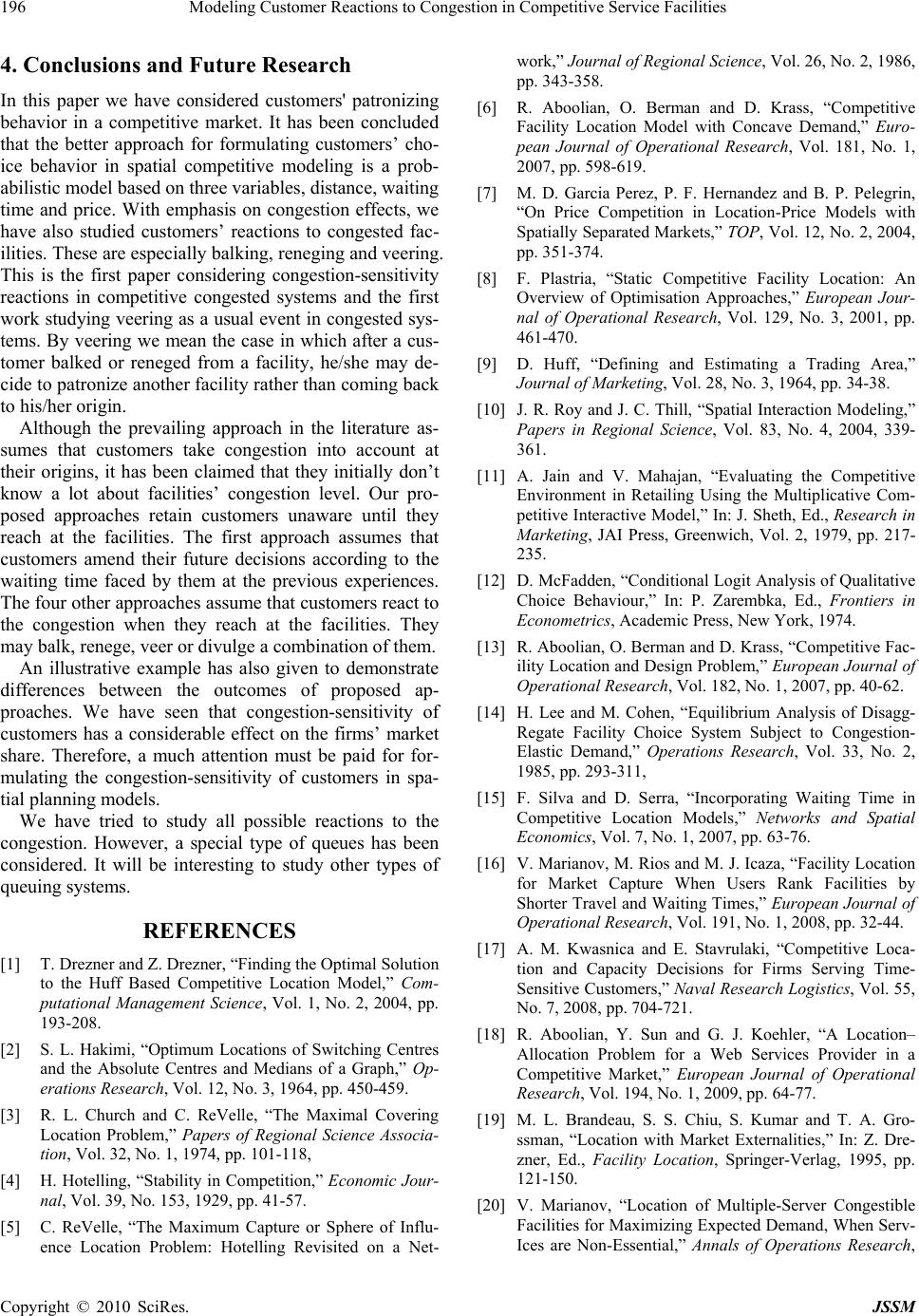
Modeling Customer Reactions to Congestion in Competitive Service Facilities
196
4. Conclusions and Future Research
In this paper we have considered customers' patronizing
behavior in a competitive market. It has been concluded
that the better approach for formulating customers’ cho-
ice behavior in spatial competitive modeling is a prob-
abilistic model based on three variables, distance, waiting
time and price. With emphasis on congestion effects, we
have also studied customers’ reactions to congested fac-
ilities. These are especially balking, reneging and veering.
This is the first paper considering congestion-sensitivity
reactions in competitive congested systems and the first
work studying veering as a usual event in congested sys-
tems. By veering we mean the case in which after a cus-
tomer balked or reneged from a facility, he/she may de-
cide to patronize another facility rather than coming back
to his/her origin.
Although the prevailing approach in the literature as-
sumes that customers take congestion into account at
their origins, it has been claimed that they initially don’t
know a lot about facilities’ congestion level. Our pro-
posed approaches retain customers unaware until they
reach at the facilities. The first approach assumes that
customers amend their future decisions according to the
waiting time faced by them at the previous experiences.
The four other approaches assume that customers react to
the congestion when they reach at the facilities. They
may balk, renege, veer or divulge a combination of them.
An illustrative example has also given to demonstrate
differences between the outcomes of proposed ap-
proaches. We have seen that congestion-sensitivity of
customers has a considerable effect on the firms’ market
share. Therefore, a much attention must be paid for for-
mulating the congestion-sensitivity of customers in spa-
tial planning models.
We have tried to study all possible reactions to the
congestion. However, a special type of queues has been
considered. It will be interesting to study other types of
queuing systems.
REFERENCES
[1] T. Drezner and Z. Drezner, “Finding the Optimal Solution
to the Huff Based Competitive Location Model,” Com-
putational Management Science, Vol. 1, No. 2, 2004, pp.
193-208.
[2] S. L. Hakimi, “Optimum Locations of Switching Centres
and the Absolute Centres and Medians of a Graph,” Op-
erations Research, Vol. 12, No. 3, 1964, pp. 450-459.
[3] R. L. Church and C. ReVelle, “The Maximal Covering
Location Problem,” Papers of Regional Science Associa-
tion, Vol. 32, No. 1, 1974, pp. 101-118,
[4] H. Hotelling, “Stability in Competition,” Economic Jour-
nal, Vol. 39, No. 153, 1929, pp. 41-57.
[5] C. ReVelle, “The Maximum Capture or Sphere of Influ-
ence Location Problem: Hotelling Revisited on a Net-
work,” Journal of Regional Science, Vol. 26, No. 2, 1986,
pp. 343-358.
[6] R. Aboolian, O. Berman and D. Krass, “Competitive
Facility Location Model with Concave Demand,” Euro-
pean Journal of Operational Research, Vol. 181, No. 1,
2007, pp. 598-619.
[7] M. D. Garcia Perez, P. F. Hernandez and B. P. Pelegrin,
“On Price Competition in Location-Price Models with
Spatially Separated Markets,” TOP, Vol. 12, No. 2, 2004,
pp. 351-374.
[8] F. Plastria, “Static Competitive Facility Location: An
Overview of Optimisation Approaches,” European Jour-
nal of Operational Research, Vol. 129, No. 3, 2001, pp.
461-470.
[9] D. Huff, “Defining and Estimating a Trading Area,”
Journal of Marketing, Vol. 28, No. 3, 1964, pp. 34-38.
[10] J. R. Roy and J. C. Thill, “Spatial Interaction Modeling,”
Papers in Regional Science, Vol. 83, No. 4, 2004, 339-
361.
[11] A. Jain and V. Mahajan, “Evaluating the Competitive
Environment in Retailing Using the Multiplicative Com-
petitive Interactive Model,” In: J. Sheth, Ed., Research in
Marketing, JAI Press, Greenwich, Vol. 2, 1979, pp. 217-
235.
[12] D. McFadden, “Conditional Logit Analysis of Qualitative
Choice Behaviour,” In: P. Zarembka, Ed., Frontiers in
Econometrics, Academic Press, New York, 1974.
[13] R. Aboolian, O. Berman and D. Krass, “Competitive Fac-
ility Location and Design Problem,” European Journal of
Operational Research, Vol. 182, No. 1, 2007, pp. 40-62.
[14] H. Lee and M. Cohen, “Equilibrium Analysis of Disagg-
Regate Facility Choice System Subject to Congestion-
Elastic Demand,” Operations Research, Vol. 33, No. 2,
1985, pp. 293-311,
[15] F. Silva and D. Serra, “Incorporating Waiting Time in
Competitive Location Models,” Networks and Spatial
Economics, Vol. 7, No. 1, 2007, pp. 63-76.
[16] V. Marianov, M. Rios and M. J. Icaza, “Facility Location
for Market Capture When Users Rank Facilities by
Shorter Travel and Waiting Times,” European Journal of
Operational Research, Vol. 191, No. 1, 2008, pp. 32-44.
[17] A. M. Kwasnica and E. Stavrulaki, “Competitive Loca-
tion and Capacity Decisions for Firms Serving Time-
Sensitive Customers,” Naval Research Logistics, Vol. 55,
No. 7, 2008, pp. 704-721.
[18] R. Aboolian, Y. Sun and G. J. Koehler, “A Location–
Allocation Problem for a Web Services Provider in a
Competitive Market,” European Journal of Operational
Research, Vol. 194, No. 1, 2009, pp. 64-77.
[19] M. L. Brandeau, S. S. Chiu, S. Kumar and T. A. Gro-
ssman, “Location with Market Externalities,” In: Z. Dre-
zner, Ed., Facility Location, Springer-Verlag, 1995, pp.
121-150.
[20] V. Marianov, “Location of Multiple-Server Congestible
Facilities for Maximizing Expected Demand, When Serv-
Ices are Non-Essential,” Annals of Operations Research,
Copyright © 2010 SciRes. JSSM